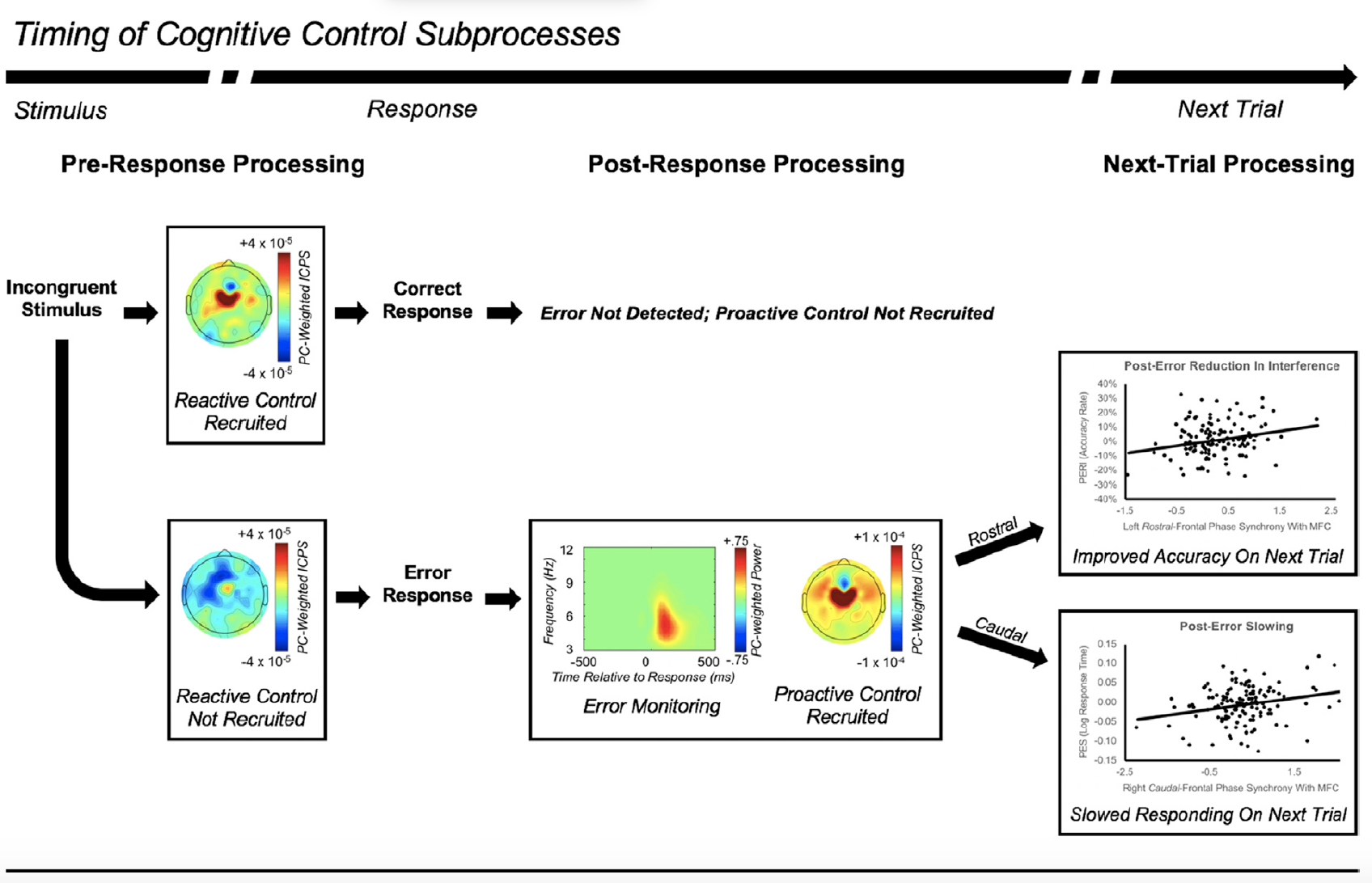Research in the NDC Lab is focused on how individuals monitor and control their behavior, a set of processes known as cognitive control, which is also referred to as “executive functioning” or “self-regulation.” Our long-term goal is to develop a unified, systems-level model of cognitive control development, leveraged to solve real-world problems like prevention and treatment of psychological disorders. Towards this end, we pursue research to:
- Identify the specific neurocognitive processes involved in cognitive control.
- Investigate the development of such processes.
- Understand how cognitive control relates to anxiety and other aspects of mental health.
In studying cognitive control, we typically employ a combination of non-invasive neural measures (EEG and fMRI) and advanced analytical methods (time-frequency analysis, source localization, and functional connectivity). Moreover, we embed our work within the context of modern statistical approaches (structural equation modeling and hierarchical linear modeling), as well as computational frameworks (drift-diffusion modeling). Below, you can find a more detailed overview of our various aspects of our research program.
Neurocognitive basis of cognitive control
We employ a variety of neural, computational, and behavioral tools to pinpoint the neurocognitive processes involved in cognitive control. In line with theory put forth by other research groups, we argue in two recent theoretical reviews (Buzzell, et al., in press; Buzzell, et al., 2018) that a minimal theory of cognitive control requires at least a conceptual distinction between processes that allow us to monitor and detect when control is needed, termed performance monitoring, and processes that actually enact control, termed control instantiation.

However, it is not always the case that performance monitoring leads to a corresponding increase in control. In fact, we have demonstrated that performance monitoring can sometimes lead to a reduction in control (Buzzell et al., 2017A; Beatty, Buzzell, et al., 2018). Thus, isolating specific processes involved in cognitive control can produce a more sensitive, reliable, and ultimately replicable approach to understanding the development of cognitive control.
We have employed techniques that combine EEG and MRI data to provide improved estimates of precisely which neural structures become activated during performance monitoring. On the one hand, we find that more medial regions of the cortex, including the anterior and posterior cingulate, as well as orbitofrontal and insular cortices, exhibit increased activity during performance monitoring (Buzzell et al., 2017B). On the other hand, we find that control instantiation typically involves coordination of medial and lateral regions of the frontal cortex through synchronization of brain oscillations within the theta band (4-7 Hz; Buzzell et al., 2019). New work in the lab will increasingly leverage source localization and computational modeling approaches to further investigate the neurocognitive basis of cognitive control.
Development of cognitive control
Exploring how cognitive control develops, we have found that a specific form of control known as inhibitory control (the ability to inhibit unwanted actions) develops longitudinally across middle childhood (Troller-Renfree, Buzzell, et al., 2019). Critically, we have found that individual differences in the COMT gene (which is associated with prefrontal dopamine function) directly predict differences in developmental trajectories of inhibitory control (Bowers, Buzzell, et al., in press). At the applied level, this work suggests the importance of considering possible gene-environment interactions when designing interventions to improve inhibitory control in children.

In contrast to the substantial improvements in cognitive control that take place across childhood, our work also demonstrates that development during the adolescent period is much more nuanced. Using approaches that combine EEG and MRI methods, we have shown that performance monitoring involves two distinct clusters of frontal brain activity: a more dorsal set of brain areas that appear to develop primarily during childhood, and a more ventral set of regions that exhibit continued development across adolescence (Buzzell et al., 2017B). Using analytic approaches that target brain oscillation patterns, we have also shown that performance monitoring involves at least two distinct patterns of brain oscillations: higher frequency brain oscillations (theta: 4-7 Hz) that appear to develop primarily during childhood, and lower frequency brain oscillations (delta: 1-3 Hz) that exhibit continued development across adolescence (Bowers, Buzzell, et al., 2018). Our work demonstrating that particular brain regions and brain oscillations display protracted development across adolescence is complemented by other work linking these same phenomena to affective processing. Taking this work a step further, a recent NARSAD Young Investigator Grant will allow us to study whether adolescent development of ventral brain networks involved in integrating affective signals and cognitive control predict the emergence of social anxiety.
Cognitive control and anxiety
Given that social anxiety is most likely to onset during adolescence, there is a potential for more cumulative harm, as socially anxious adolescents withdraw from social interactions during a crucial period of development. Thus, it is critical to identify improved predictors of risk for social anxiety and discover underlying mechanisms that can inform novel intervention approaches. As a model system for studying the development of social anxiety, we have focused on the temperament of behavioral inhibition, which is characterized by negative reactivity towards novelty. While early risk for social anxiety can be predicted based on a child’s temperament, our work consistently demonstrates the added value of considering cognitive control in the development of social anxiety.

